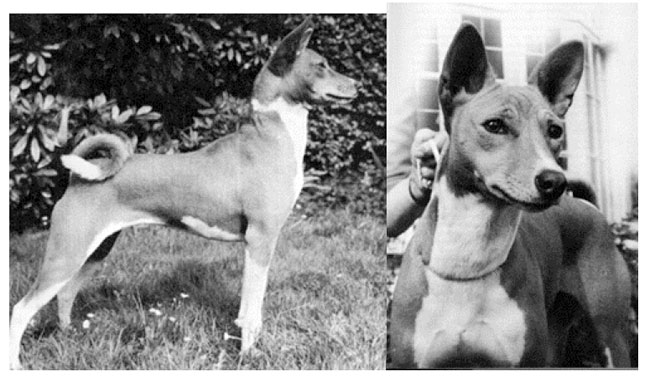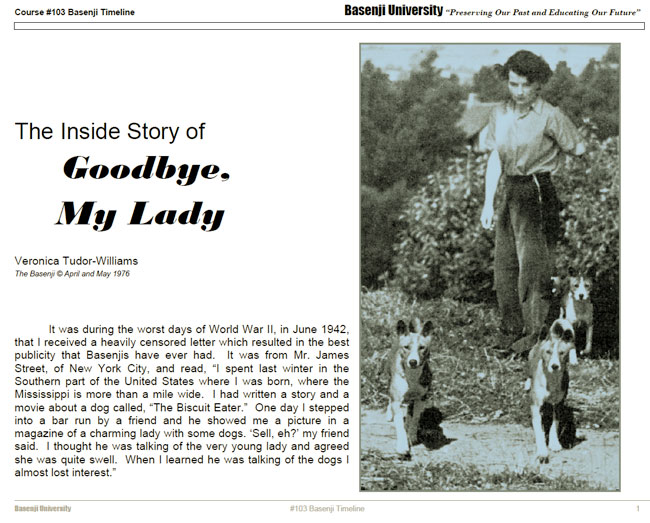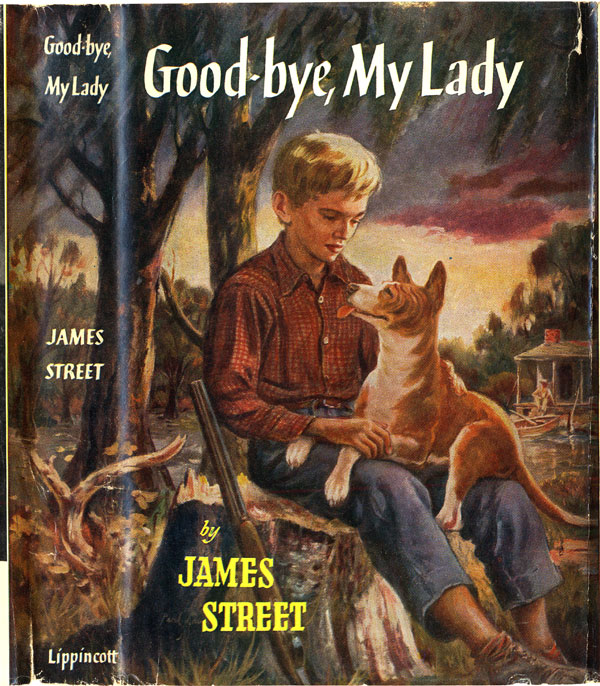Volume XX, Issue 3, August 2016
Page 14 < previous page > <next page>


 Native Names in the Southern Sudan
Native Names in the Southern Sudan


by Veronica Tudor-Williams
This article was written in March 1960 and first published in the inaugural issue of the Basenji Club of Great Britain’s Chronicle in 1963, and reprinted in the June 2004 issue of that magazine. It is reprinted with permission of the Basenji Club of Great Britain, and was reprinted in the February 2006 Wrinkler with the kind collaboration of Peter Morant, then editor of the Western Yodel.
Veronica Tudor-Williams was a doyenne of the breed and President of the BCOGB, the world’s oldest Basenji Club, from 1960 to 1987. She died in 1989.
She wrote:
Before I left for the South Sudan I was often asked “what we would do about the dogs’ names, and whether we would be able to get any pedigrees. I was almost as uncertain about this as my questioners, except that I remembered that Mr. Arthur Byron bought a very young puppy in the South Sudan many years ago, and when he asked her name, the reply was instantly given “Amatangazig”. When Mr. Byron asked for a translation, all he got was a bawdy laugh, and he enquired no further. When out in the Sudan I learnt that Amatangazig has an anatomical meaning not at all suitable for polite society. It is a Zande word, and I was always getting into trouble, I would say a dog looked “just like Amatangazig” and would be hushed by my companions because the Zandes knew its meaning.
Among the Zandes the first thing asked would be our names, then we would ask their names; next our tribe would be given as “Englezi”, we of course, knowing their tribe as Zande. Next we would ask the names of their dogs, and the answers would be given just as readily. The amusing part was, the dogs were nearly always named after the deficiencies of either husband or wife. One dog was called “Litta”, the loose man of the village, and another was called Nguaguru, “the Big Stick”, so one can imagine the jolly partnership. This remark though is really rather unfair, as the Zandes are a clean, gentle and kindly people, known as the “Gentle Savages” and I think the dogs’ names just show their nice sense of humour.
When I purchased Fula, she was the only puppy we ever saw wearing a collar. She had a brightly coloured strip of native cloth tied around her neck in a bow, and a most engaging little scrap she looked, weighing about 3 lbs [1.4 kg] at about 7 weeks old. When I asked her price, this was quoted to me as “including the collar”. I immediately bought her, and the collar, and about a hundred fleas into the bargain. I asked her name, which I wrote on the back of an envelope, still in my possession. This was Fula, meaning a cork, I spelt it Foula, and was instantly corrected. Her breeder was a beaming black Zande, only too delighted to give his name, Sayed Ruge.
Rather doubtfully I asked the names of Fula’s parents, and without hesitation I was told “Bobi” was her father and “Danakide” her mother. These names were given as quickly as if I had asked the names of Sayed Ruge’s own parents. Then I asked Habukukk, our interpreter, for translations and this was where the hesitation came. He told me that he could not translate Bobi, and looked rather embarrassed. I jumped to conclusions and said “Oh yes, like a pet name, which has no translation”, and he seemed very relieved.
I have since decided that Bobi was probably a very rude word, which a Zande gentleman could not repeat. I only wish I had thought of this at the time, and got my companions to investigate the matter when I was out of earshot. Fula’s mother was an easy name Danakide, “the one who broke it” though it would be fun to know just what she broke, and how far it strained the marriage partnership. The grandparents involved a little more thought, though we had not much time at our disposal, Fula only being produced just (as) we were about to load into the Land Rover. However, these proved to be: “Wese” meaning “smooth” possibly referring to coat, which is borne out by Fula, who has a particularly smooth fine coat; “Dogati”, meaning “Vain Trial”, one wonders what Zande justice was involved in this; “Kuabase”, meaning “Breaker of Swords” – could this be a great hunter, or only someone who was careless?; and “Avuru”, translated as “Even though”, which rather leaves one in the air.
Then came the question of Fula’s age; we did not worry much, as we were all dog breeders and we could judge her as being around 6 – 8 weeks. Actually judging by her teeth 2 months later, she was all of 8 weeks, but was so tiny and fine- boned compared with English Basenji puppies, we underestimated her age. To her native owner her age was a mystery, he simply did not know, a circumstance we readily understood, as we had struck this before. Time means nothing to the natives of the Southern Sudan. Why should it, the sun rises, and the sun sets, just the same each day, so why should days matter? The only big events are the Big Rains and the Big Droughts, but even time is difficult to tell by this.
As far as we are concerned, Fula was acquired on May 12th, 1959, so she is registered at the English Kennel Club as born March 1959, a month which is bound to cover her birth. When I look at her, I often wonder what her thoughts would be if she remembered her native village, and how she left obscurity in the Southern Sudan to be a pampered pet in England. Maybe she would prefer the sunshine and the freedom, but knowing her, I suspect she likes her comforts and has her eye on future fame.

Comments by Doreen Duffin
Makuba Basenjis, Melbourne, Victoria, Australia
Fula was lovely type. Admittedly she was rather elderly when I saw her, but she still was the lightly built, finely boned, high on leg, aristocratic looking dog that the Standard calls for. She had a good length of neck that flowed beautifully into her shoulders, and she had elegance, which is lacking in so many Basenjis. She was definitely true Basenji type. She wasn't tall, but I'd say within Standard. Her head was good, (probably would have been quite typey in her younger days, and by photos taken earlier, it was), with lovely almond shaped, obliquely set eyes, but she did have large-ish ears and I remember Elspet Ford always wondering why our Standard calls for small ears on a native hunting dog which needed exceptional hearing. I'm sure she could have done the job for which she was bred - which is the first thing any judge must ask him/herself when a dog comes into the ring "can that dog do the job for which it's bred?"
It is a pity there aren't more around like Fula now.
See this YouTube video of Veronica Tudor-Willaims and her dogs.
The Inside Story of Goodbye My Lady, by Veronica Tudor Williams (on Basenji U)

